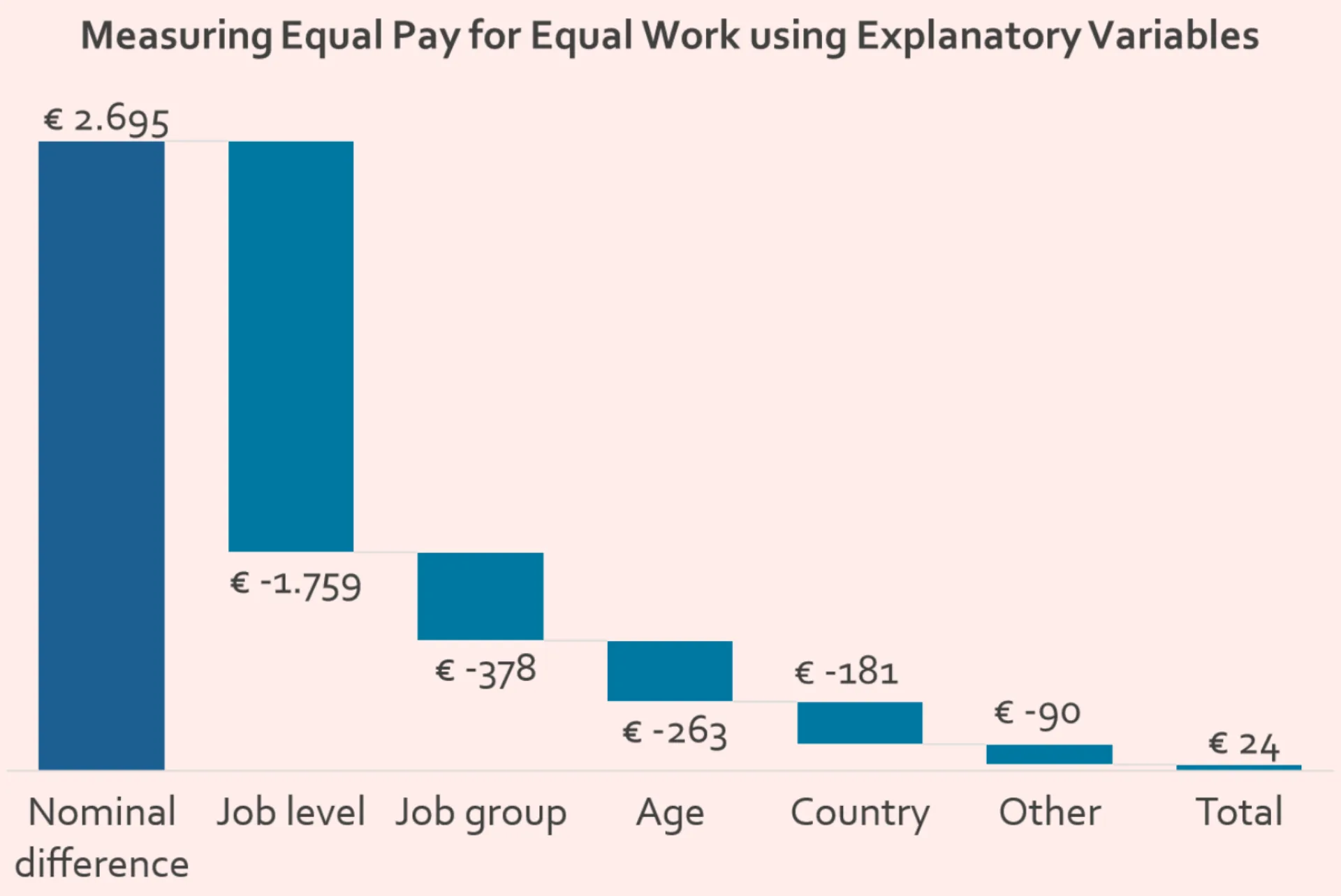Understanding equal pay
In 1957, the European Union adopted a treaty establishing that men and women should receive equal pay for work of equal value. Although this law has been in place for more than 65 years, there is still a clear difference in pay between men and women. For example, the most recent benchmark by Statistics Netherlands shows that men earn on average between 3 per cent and 6 per cent more than women for the same work. Fortunately, more companies are realizing the importance of gender equality in the workplace and the role that equal pay for equal work plays in this. Yet it is not clear to many companies. What exactly is equal pay for equal work?

Key Insights:
- The pay gap and equal pay for equal work are two different things. The pay gap looks at the average salary difference, while equal pay for equal work calculates an adjusted compensation difference, taking factors such as job level or length of service into account
- Equal pay for equal work does not just pertain to men and women; it also matters for distinct groups, like those with diverse cultural or age backgrounds
- On February 29, Highberg is hosting a webinar to inform about equal pay for equal work, upcoming legislation, and how companies can investigate this
Often when talking about equal pay, people mention the average difference in pay between men and women. However, this is not the definition of equal pay for equal work, but for the pay gap, also known as the nominal difference. The problem with the gender pay gap is that it only looks at gender as an explanation for the income gap. In this scenario, it can happen that apples and oranges are being compared. Suppose that in an organization, all men work in higher positions than women. If the wage gap is then calculated, it turns out that men earn a lot more on average than women. Despite the fact that there may be a pay gap in this organization, this does not necessarily mean that men and women are not equally paid for the same work. However, when there is a pay gap, it can indicate a flow problem or a glass ceiling.
In the Netherlands, the gender pay gap is currently 13 per cent. Broken down by sector, this is 16 per cent in the private sector and 5 per cent in the public sector. Based on this 13 per cent, Equal Pay Day is also calculated annually: from that day on, women work 'for free', so to speak. For example, if you calculate 13 per cent of 365 days, you end up on November 14. This will be the date for Equal Pay Day this year.
What Equal Pay for Equal Work means
As a solution to the problem of comparison, one can look at pay differences between men and women performing the same job. However, this is a challenging comparison because there are many factors influencing pay. Therefore, equal pay for equal work is investigated by calculating an adjusted compensation difference. This calculation takes into account background variables such as job level, length of service, age, type of employment, and educational level. An analysis is conducted to determine how much impact these background variables have on the total compensation. Then, this impact can be used as a basis for the adjusted compensation difference. In the image below, there is an example of how the adjusted compensation difference can be explained by background variables.
The figure shows how the nominal difference is turned into a corrected pay gap. The nominal difference, in this case the amount that men earn more than women, is 2,695 euros. However, 1,759 euros can already be explained by job level; in this example, men are more often in higher positions than women. If corrections are made for the other variables, in this case job group, age, country and others, the corrected pay difference amounts to 25 euros. This rounded up is almost a zero per cent difference. Thus, this figure clearly shows why the adjusted pay gap is a better measure of pay equity.
However, even with the corrections, there is still a pay inequality in the Netherlands. For example, the most recent benchmark by Statistics Netherlands shows that in the business world, men still earn on average 6 per cent more than women for the same work. Within government organizations, this difference is generally smaller, but here too, men earn an average of 3 per cent more than women.
However, it is important to emphasize that pay inequality is not limited to just the difference between men and women, but extends to other diverse groups of employees, for example based on factors such as cultural background or sexual orientation. Often, these pay inequalities are not solely due to discrimination, but are rooted in deeper structural and cultural aspects within organizations.
As a solution to the problem of comparison, one can look at pay differences between men and women performing the same job. However, this is a challenging comparison because there are many factors influencing pay. Therefore, equal pay for equal work is investigated by calculating an adjusted compensation difference. This calculation takes into account background variables such as job level, length of service, age, type of employment, and educational level. An analysis is conducted to determine how much impact these background variables have on the total compensation. Then, this impact can be used as a basis for the adjusted compensation difference. In the image below, there is an example of how the adjusted compensation difference can be explained by background variables.

The figure shows how the nominal difference is turned into a corrected pay gap. The nominal difference, in this case the amount that men earn more than women, is 2,695 euros. However, 1,759 euros can already be explained by job level; in this example, men are more often in higher positions than women. If corrections are made for the other variables, in this case job group, age, country and others, the corrected pay difference amounts to 25 euros. This rounded up is almost a zero per cent difference. Thus, this figure clearly shows why the adjusted pay gap is a better measure of pay equity.
However, even with the corrections, there is still a pay inequality in the Netherlands. For example, the most recent benchmark by Statistics Netherlands shows that in the business world, men still earn on average 6 per cent more than women for the same work. Within government organizations, this difference is generally smaller, but here too, men earn an average of 3 per cent more than women.
However, it is important to emphasize that pay inequality is not limited to just the difference between men and women, but extends to other diverse groups of employees, for example based on factors such as cultural background or sexual orientation. Often, these pay inequalities are not solely due to discrimination, but are rooted in deeper structural and cultural aspects within organizations.
Related insights

